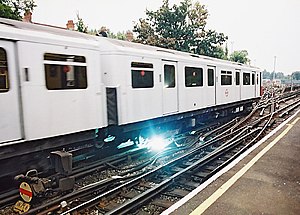| Revision as of 10:23, 17 August 2006 editBaseTurnComplete (talk | contribs)Extended confirmed users1,932 edits →1500 V DC Overhead: updated Woodhead, removed incorrect assertion re Beeching← Previous edit | Revision as of 10:23, 17 August 2006 edit undoBaseTurnComplete (talk | contribs)Extended confirmed users1,932 editsm →1500 V DC OverheadNext edit → | ||
| Line 27: | Line 27: | ||
| ] | ] | ||
| * ] line, also known as the ] Line, closed in 1981 | * ] line, also known as the ] Line, closed in 1981 | ||
| * ] (Great Eastern Main Line) - converted to 25K v AC | * ] (Great Eastern Main Line) - converted to 25K v AC | ||
| * ] - over former Tyneside electrics | * ] - over former Tyneside electrics | ||
Revision as of 10:23, 17 August 2006
40% (3,062 miles / 4,928 km) of the British rail network is electrified and 60% of all rail journeys are by electric traction (both by locomotives and Multiple Units).
650 to 850v DC Third rail

- LWSR / Southern Railway / Southern Region of British Railways - everything but a few freight branches, Marshlink, North Downs Line, Uckfield branch of the Oxted Line and services through Salisbury.
- Merseyrail Electrics (Merseyrail)
- Glasgow Subway ?
- Tyneside Electrics (de-electrified by BR in 1960 then turned into Tyne and Wear Metro )
- Docklands Light Railway (bottom contact third rail)
630 V DC Fourth Rail

- London Underground
- LNWR - London suburban network - Euston and Broad Street to Watford Junction, Croxley Green and Richmond ( North London Line and Watford DC Line )
1200 V DC Side Contact rail
1500 V DC Overhead

- Manchester-Sheffield-Wath line, also known as the Woodhead Line, closed in 1981
- Shenfield Metro (Great Eastern Main Line) - converted to 25K v AC
- Tyne and Wear Metro - over former Tyneside electrics
3500 V DC Overhead
6600 (6.6K) V AC Overhead @25Hz
- LBSCR
- Shenfield Metro (Great Eastern Main Line)
- Lancaster to Heysham via Morecambe (Morecambe Branch Line)
25000 (25K) V AC Overhead @50Hz

- LTS - converted from 6.6K V AC overhead
- GEML - converted from 6.6K V AC overhead and 1500 V DC overhead
- ECML - in the 1980s
- MML (only to Bedford) - in the 1980s
- WCML - in the 1950s under the 1955 BR modernisation plan to Birmingham (new Street) / Liverpool (Lime Street) / Crewe / Manchester (Piccadilly). Extended in the 1970s to Glasgow. In 2003 Crewe to Kidsgrove section of the Crewe to Derby Line was electrified as a diversionary route for the WCML.
- Glasgow Suburban (see SPT and Transport in Glasgow) - started in the 1950s under the 1955 BR modernisation plan.
- Leeds to Skipton (Airedale Line) / Leeds to Bradford ( Wharfedale Line )
- Manchester suburban parts ...
- Birmingham Cross-City Line
- GWML (only to Heathrow - see Heathrow Express and Heathrow Connect)
- CTRL
- Crossrail (Proposed)
See also
- Railway electrification system
- Railroad electrification in the United States
- List of current systems for electric rail traction